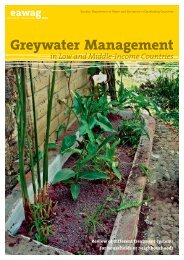Household Water Treatment and Safe Storage Factsheet: Source ...
Household Water Treatment and Safe Storage Factsheet: Source ...
Household Water Treatment and Safe Storage Factsheet: Source ...
Create successful ePaper yourself
Turn your PDF publications into a flip-book with our unique Google optimized e-Paper software.
<strong>Household</strong> <strong>Water</strong> <strong>Treatment</strong> <strong>and</strong> <strong>Safe</strong> <strong>Storage</strong><br />
Fact Sheet: Chlorine (Sodium Hypochlorite)<br />
The <strong>Treatment</strong> Process<br />
Potential <strong>Treatment</strong> Capacity<br />
Very Effective For: Somewhat Effective For: Not Effective For:<br />
Bacteria<br />
Viruses<br />
Some protozoa<br />
Helminths<br />
Cryptosporidium parvum<br />
Toxoplasma oocysts<br />
Turbidity<br />
Chemicals<br />
Taste, odour, colour<br />
What is Sodium Hypochlorite?<br />
Chlorine began to be widely used as a<br />
disinfectant in the early 1900’s. It<br />
revolutionized drinking water treatment <strong>and</strong><br />
dramatically reduced the incidence of<br />
waterborne diseases. Chlorine remains the<br />
most widely used chemical for water<br />
disinfection in the United States.<br />
Sodium hypochlorite is one form of chlorine<br />
used for water disinfection. It can be<br />
manufactured in most locations since it can<br />
be obtained through the electrolysis of salt<br />
water.<br />
Bottles can be purchased for household<br />
water treatment from many manufacturers in<br />
various sizes. Chlorine concentrations range<br />
from 0.5 to 10% <strong>and</strong> each product should<br />
have its own instructions for correct dosing<br />
of contaminated water. Liquid household<br />
bleach also contains sodium hypochlorite,<br />
<strong>and</strong> is widely available.<br />
How Does it Remove Contamination?<br />
Chlorine forms hydrochlorous acid when<br />
added to water which reacts through<br />
oxidization with microorganisms <strong>and</strong> kills<br />
them.<br />
Three things can happen when chlorine is<br />
added to water:<br />
1. Some chlorine reacts through<br />
oxidization with organic matter <strong>and</strong> the<br />
pathogens in the water to kill them.<br />
This portion is called consumed<br />
chlorine.<br />
2. Some chlorine reacts with other organic<br />
matter, ammonia <strong>and</strong> iron <strong>and</strong> forms<br />
new chlorine compounds. This is called<br />
combined chlorine.<br />
3. Excess chlorine that is not consumed or<br />
combined remains in the water. This<br />
portion is called free residual chlorine<br />
(FRC). The FRC is the most effective<br />
form of chlorine for disinfection<br />
(particularly for viruses) <strong>and</strong> helps<br />
prevent recontamination of the treated<br />
water.<br />
Air Rahmat, Indonesia<br />
(Credit: Tirta/JHUCCP)
















